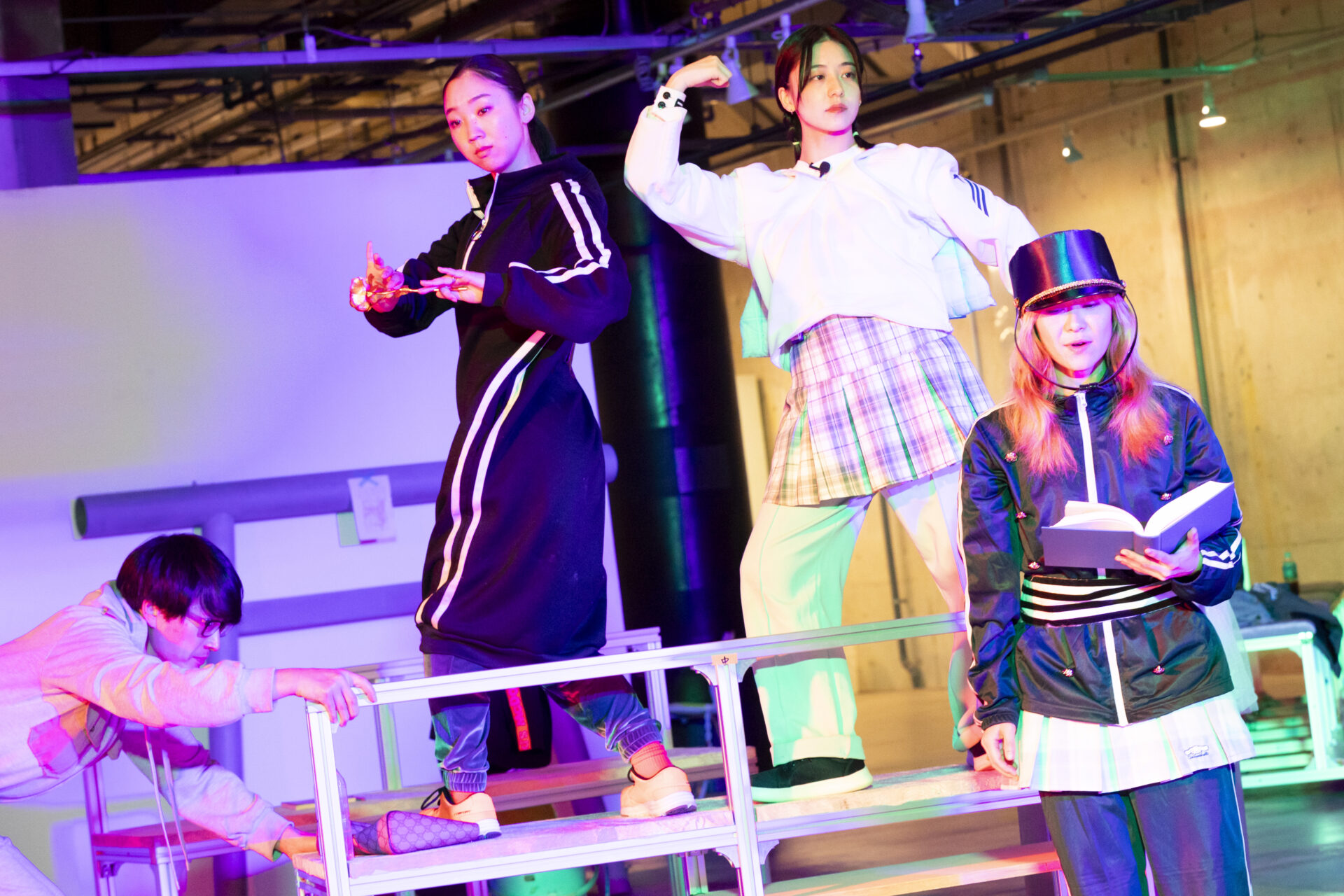Theater critic. Born in Gifu Prefecture in 1978, Takahashi is an associate professor in the Drama Course at Toho Gakuen College of Drama and Music and holds part-time lecturer positions at several institutions, including Japan Women’s University and Tama Art University. He serves as a lecturer in the Critique of Performing Arts series given at Setagaya Public Theatre and in the Za Koenji Creative Theatre Academy. He has regular columns in the Teatro and Tosho Shinbun (The Book Review Press) magazines, and has held fellowships with the Asian Cultural Council (in 2013) and the Shiba Ryotaro Memorial Foundation (6th).
OLTA The Japanese Ideology, photo by Hideto Maezawa
Starting from smallness: YPAM 2023
The 2023 edition of the Yokohama International Performing Arts Meeting (YPAM) has concluded. While the host city—Yokohama—remained the same, the center of the event appeared to have moved from Koganecho to the Minami-Ota area along the Keikyu Line. Some of the meeting’s venues in the direction of the Minatomirai Line had been retained, but they had been made more localized than before. As a result, this year’s event gave off a sense of local, community-oriented smallness.
Of course, those participating were globally active artists, producers, presenters, sponsors, and others involved in the performing arts from around the world, as well as spectators. For those used to moving and roaming around the globe, this small locality may have appeared like a station or a wharf, a place where one could come to a brief stop.
Naturally, those who gathered there all brought with them their own localities—cities and other places around the world—in the form of their respective backgrounds. This small locality, the place they visited to attend YPAM, and the locality of each community; the two came together as a true horizon of globality, which emerges when the peculiarities of different regions are connected. Rather than emphasizing only differences, or unnecessarily focusing on universality, the 2023 edition of YPAM may, from a position of smallness, have sought to highlight a perspective yet to be seen.
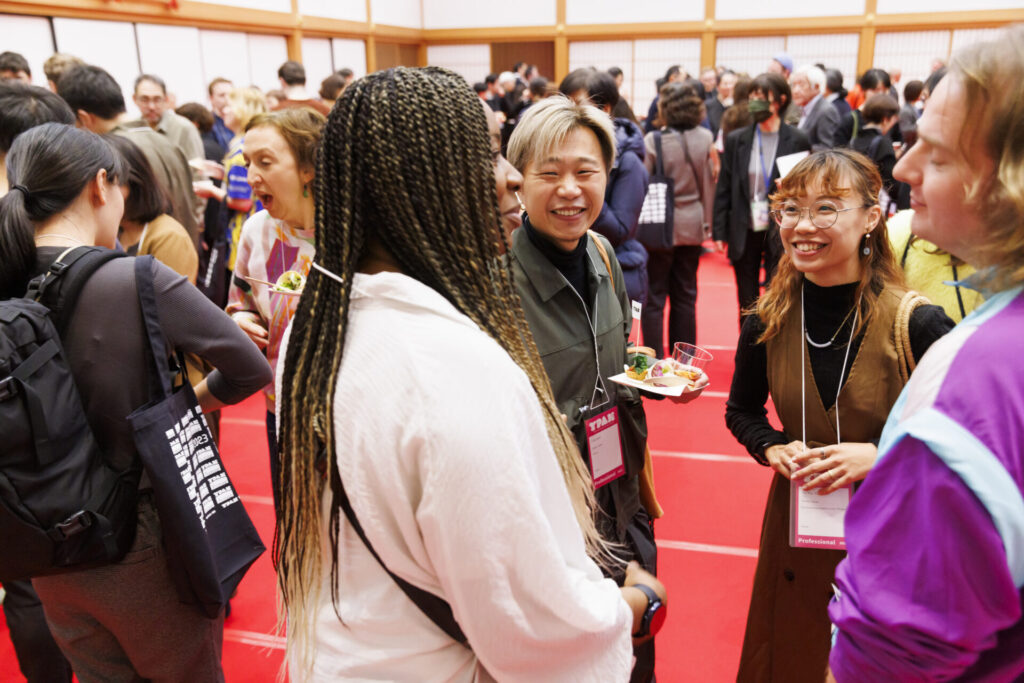
Reception at Sojiji-temple, photo by Hideto Maezawa
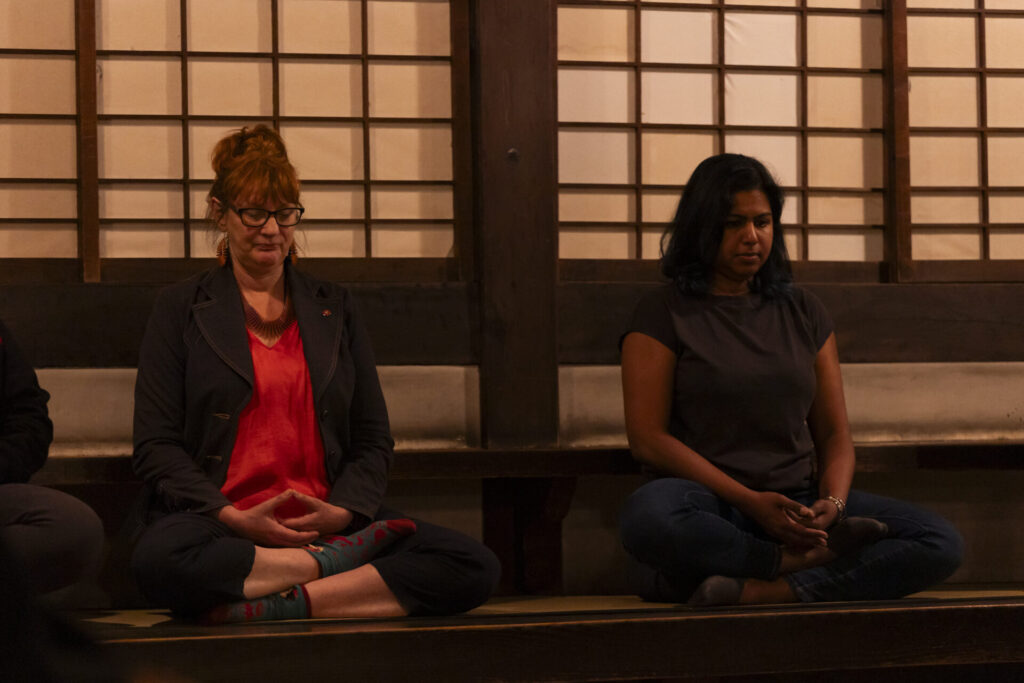
Zazen at Sojiji-temple, photo by Hideto Maezawa
One of the ways in which the event sought to achieve this was through the establishment of the YPAM Fringe Society, announced at the opening ceremony on December 1. The aim of YPAM, as suggested by the “Meeting” part of its name, now appears to be the creation of a loose community that goes a step beyond the meetings held to incorporate the voices of participants in the Fringe program.
Another project realized by working from the ground up was a reception held at Sojiji, the head temple of the Soto Zen school of Buddhism. Zen was introduced to the West by the likes of D.T. Suzuki and Eugen Herrigel, author of “Zen in the Art of Archery.” Mysticism and Orientalism may in the past have played a strong role in the popularization of Zen as Japanese culture, but here the actual experience of Zen allowed visitors to get close to the locality.
From the Fringe Program
To touch on that smallness, I’d like to start by reporting on some of the works in the Fringe program.
“Stream,” a work conceptualized, choreographed, and directed entirely by one person, Pijin Neji, was performed at the Wakabacho Wharf theater in the neighborhood next to Koganecho. The work listed a number of events that become topics of public discussion since the beginning of the Covid-19 pandemic in Japan. The changes that occurred in Neji’s own life were superimposed on these events.
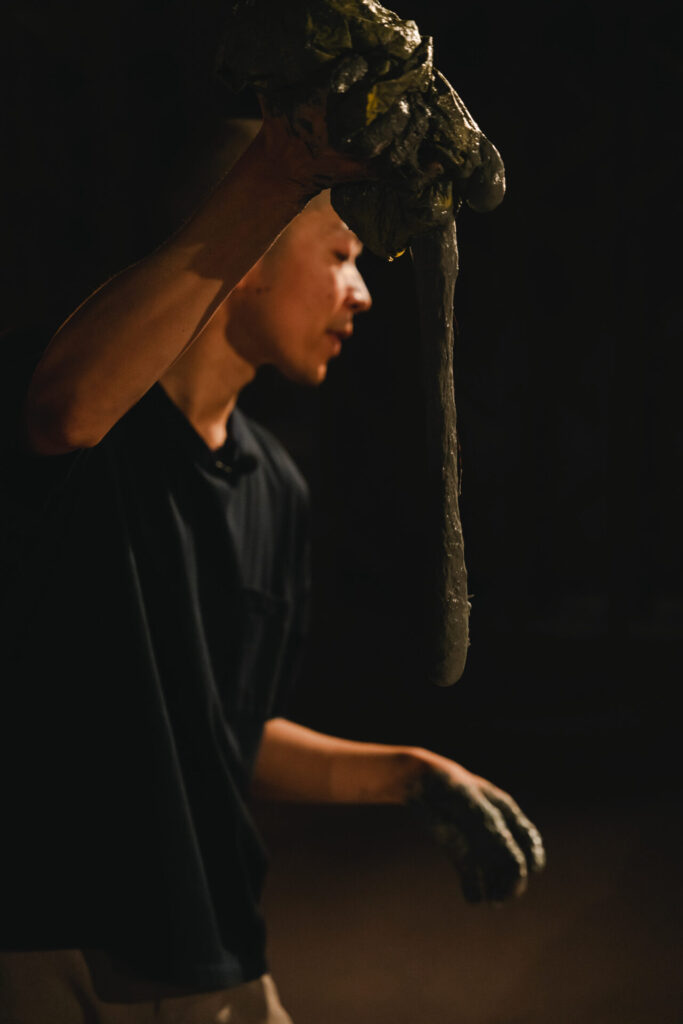
Pijin Neji Stream, photo by Tomo Wakita (Spica)
Some scenes were spoken like recitations, while in others gestures were employed as if to act out something. Those movements could be described as dancing, wavering, twirling, or even floating. These elements were inserted throughout the work.
The readings, even taken on their own, were quite elaborate. When it seemed that Neji himself was speaking, his own voice would overlap with a recording, which would then take over entirely. Though he was talking about his daily life, recalling things like waking up in the morning or playing with his cat, this speech was occasionally elevated into vivid descriptions of life through techniques such as the repetition of onomatopoeic sounds of thunder. The result drove home the duality of the larger situation of the pandemic and the raw voice of someone caught up in it all; a sort of structural juxtaposition of the objective fact of the pandemic and the subjective thoughts of an individual.
The performer’s twirl-like gestures thus become metaphors for what he should do during the pandemic, what he actually did, and how he was “floating in the air” in the midst of the situation. Parts such as when Neji talks about taking a job as a garbage collector, a lifeline necessary for society, in order to make a living during the pandemic, strike at the realistic side of things. “Stream” may be a small piece, but one that is both deep and precise, thanks in part to the excellence of its direction.
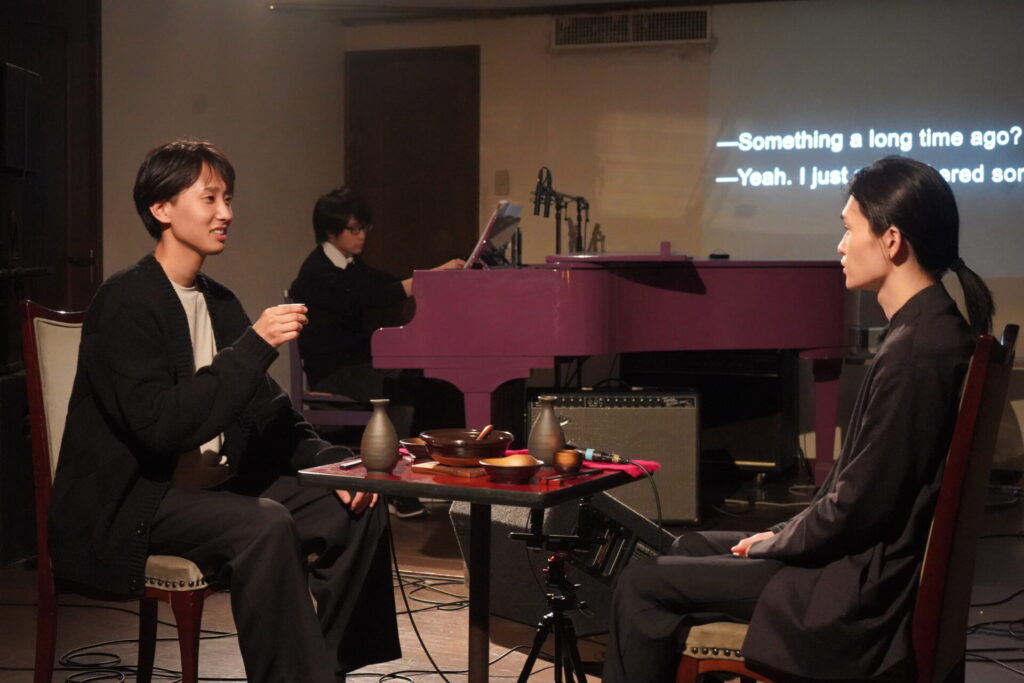
gekidan awai SONNET Jazz ver.
The emerging Theatre Company gekidan awai performed “SONNET Jazz ver.” (written and directed by Kentaro Otsuka) at a chanson bar in Hinodecho. Quoting and collaging essays by Kenichi Yoshida, a scholar of English literature, as well as portions of translated texts by Shakespeare and Oscar Wilde, the company elevated these elements into a text inspired by the worldview of these authors. The performance took place in a chanson bar, and the sounds played by the bar’s band produced a strange sensory relationship with what was happening on the stage. Once performed in a traditional Japanese house (https://www.youtube.com/watch?v=I_uGu-TQW5Q), the work’s contrast between its characters’ nonchalant conversation over hot tofu and the chanson bar made for an exquisitely serious and funny experience.
These conversations and gestures, whether inspired by Kenichi Yoshida or not—but including frequent meta-level references to his work through words like “critique” and “form”—revealed the stance of the author’s own critical style deep within those muted dialogues.
From the Direction Program
This year’s featured YPAM Direction work was the OLTA group’s “The Japanese Ideology”—finally presented in full form here, having been developed from last year’s work-in-progress version. The piece itself is unique in form; it can just as well be described as a grand work and as a small production.
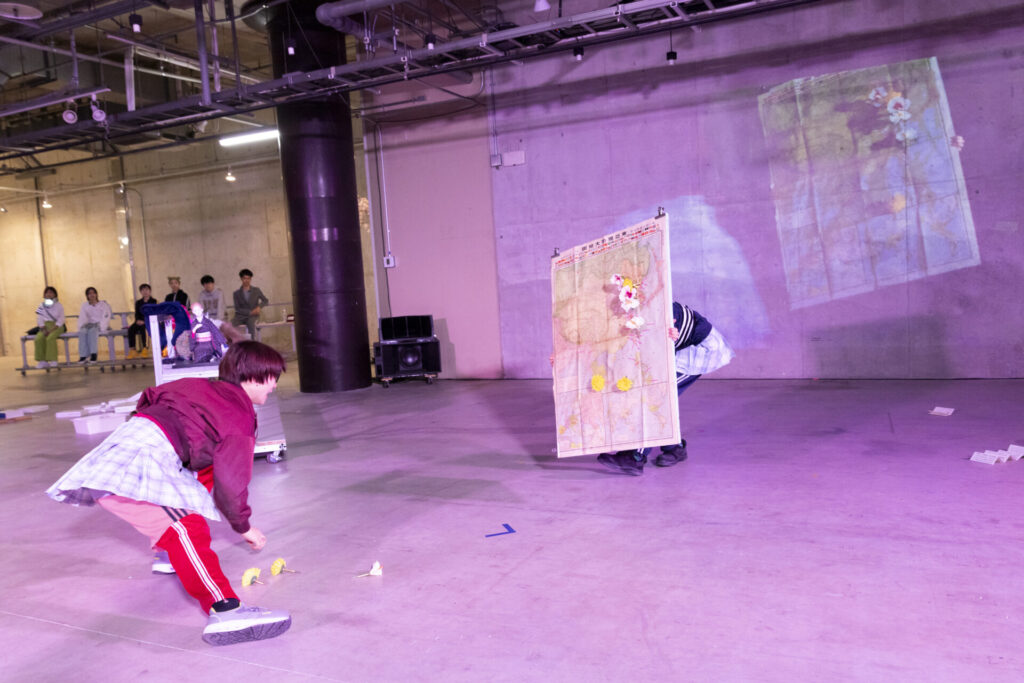
OLTA The Japanese Ideology, photo by Hideto Maezawa
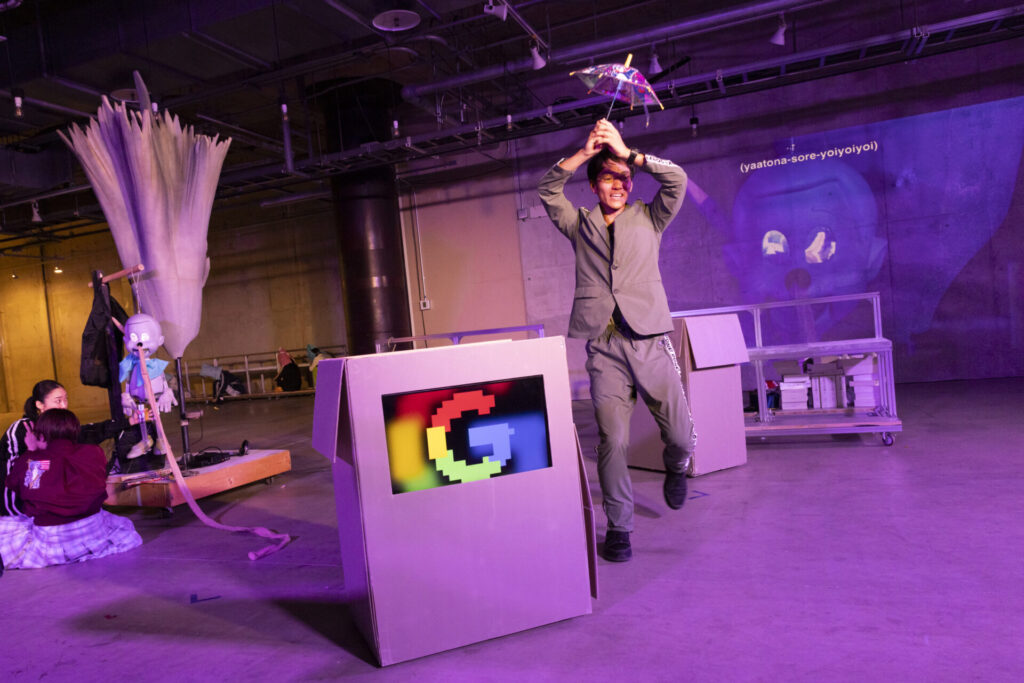
OLTA The Japanese Ideology, photo by Hideto Maezawa
Each chapter is less than an hour long, but the full work has six of them, making the total runtime almost six hours. As the stage is redone for each chapter, these are best considered complete works in their own right rather than a series of acts. However, seeing only one chapter alone leaves the viewer unsatisfied. What all the works have in common is that they are performances without a clear beginning or end point, without a linear plot.
However, the work makes one wonder what methods can be employed to represent ideology in the form of performance. In a conventional play, would the story have an ideologue as the protagonist? As if to eschew such a method, this work seemed to pursue the representation of ideology itself by presenting ideological information, words, historical events, and symbolic monuments. On their own these may seem like fragments, and together an accumulation of fragments, but as discourse, they somehow take on the aspect of Japanese ideology. Various materials placed in the space, including torpedoes, automatic doors, and Pinocchio dolls, helped make this ideology appear tangible.
If I were to suggest a motif for each work, then the first chapter’s theme would be the Emperor system, given the discussion of broadcasting of the voice of Japan’s Emperor Hirohito after Japan’s defeat in World War II. The second chapter is about food, including konjac. The third work highlights history through works such as the “Tale of Genji,” discussed through the concept of contemporary theater in classical vernacular. The fourth work is about the history of Okinawa and the issue of military bases, the fifth is about Zainichi Koreans, and the sixth chapter takes on war, which is the work’s overarching issue. Parts four and five in particular stand out for their treatment of specific political issues and ideologies through detailed narratives.
After watching all six chapters, I felt as if the discourse of ideology had gained mass. The thinness of ideology in wartime Japan and the weight of the lives of those affected by this ideology make us think not so much about the depth of ideas, but rather about the very foundations of what ideology is.
From the YPAM Joint Program
The “Italian Contemporary Dance Showcase” was an interesting program composed of four works, one of which I’d like to highlight here.
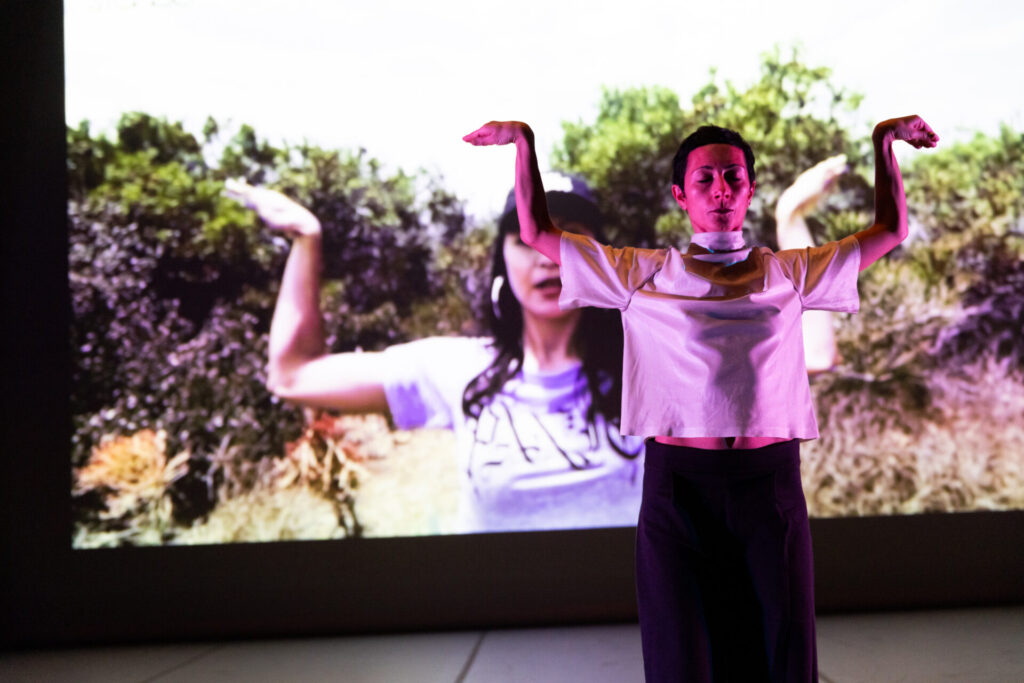
Jacopo Jenna Some Choreographies, photo by Hideto Maezawa
Jacopo Jenna’s “Some Choreographies” was composed of a collage of images projected onto a screen in the background and the movements of a single dancer on stage. The images were remixed and referenced, in no particular order, numerous famous works from the history of contemporary dance. Traveling across a wide variety of genres, from ballet to postmodern dance and to hip-hop and other forms of contemporary dance entertainment, the footage included appearances by the likes of Kurt Jooss, Mary Wigman, Pina Bausch, Rosas, and Trisha Brown, to name only a select few. From the world of cinema, a dance scene from Godard’s “Band of Outsiders” had also made the cut.
The movements of the dancer on stage were then derived from the footage. For example, as scenes of twisting and lifting up followed each other on the screen, the dancer would imitate these motions. While the movements themselves are the same in both dimensions, there are obviously substantial differences in terms of the performers’ bodies. In other words, cutting out a fragment of a dance serves to emphasize the differences in movement and style across performers.
The latter half of the piece employed imagery that seemed to question the nature of dance itself. Depictions of the movement of insects and animals appeared to raise questions about what it means to move and dance, and moreover, what gestures and choreographies really are.
Relatedly, Singaporean performing artist Choy Ka Fai produced a work mixing dances from past masterpieces with irony in an attempt at “meta-dance,” rather than meta-theater. However, though the work was influenced by great historical pieces, it employed a style that excluded irony from the representation, giving precedence to the intensity of art.
From the Exchange Program
The Exchange program included symposia, presentations, roundtables, and showcases in the form of studio showings. The discussions spanned a variety of themes, but the undercurrent appeared to be that these wouldn’t attempt to represent countries or major historical events.
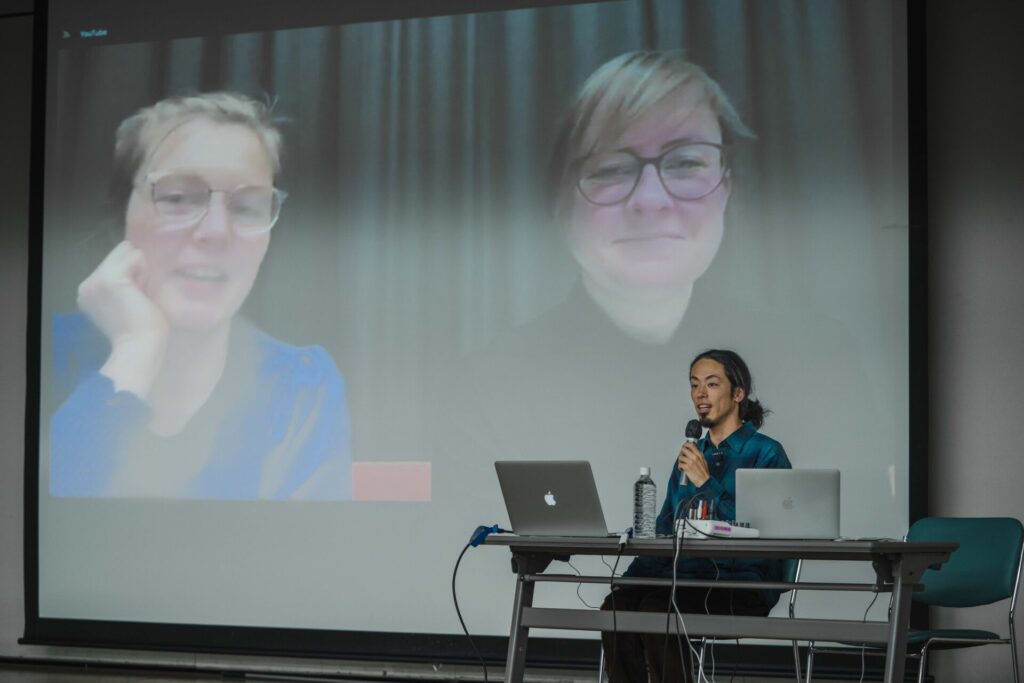
Exchange program, photo by Ryusuke Ohno
For example, “Uredd/Fearless – Developing and establishing artistic practices in the Nordic” was about the art scene in northern Norway. Participants were given an overview of this scene, with a focus on the Davvi Centre for Performing Arts, beginning with geographical and historical background and followed by discussion of theaters and organizations, including through presentations by select artists.
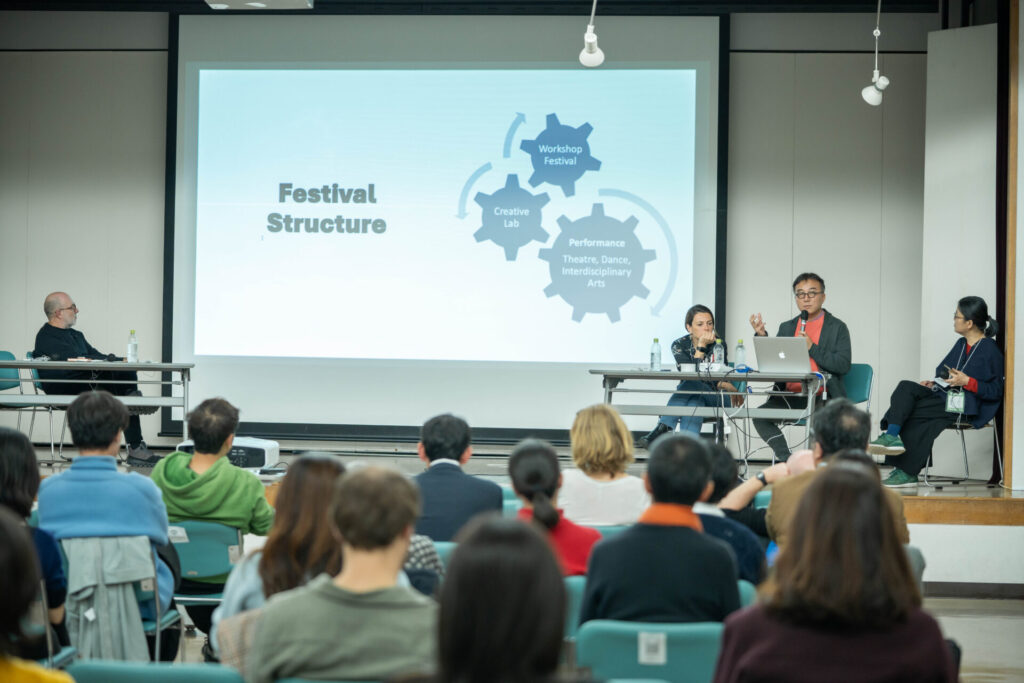
Exchange program, photo by Ryusuke Ohno
Meanwhile, “Shaping the Future of Performing Arts: Dialogues with Festival Experts,” co-hosted by the Japan Foundation and YPAM, invited festival directors from Madrid (Spain), Seoul (Korea), and Istanbul (Turkey). Representing major festivals in world cities, participants discussed the values and localities behind their respective events, which are carnival-like spaces of diversity.
Taken on their own, the programs and works I’ve described are certainly all small. YPAM, an equally small platform, is seeking to connect the “smallnesses” conceived in each city and region under their respective global circumstances—as if that was where everything starts.
Translated by Ilmari Saarinen
INFORMATION
YPAM (Yokohama International Performaning Arts Meeting) 2023
Period: December 1–17, 2023
Venues: KAAT Kanagawa Arts Theatre, Yokohama Red Brick Warehouse No. 1, BankART Station, Soto Zen Buddhism Sojiji Head Monastery, Forum Minamiota (Gender Equality Center Yokohama South), Amazon Club, and others
Organized by: Yokohama International Performing Arts Meeting Executive Committee (Kanagawa Arts Foundation; Yokohama Arts Foundation; Japan Center, Pacific Basin Arts Communication)
Co-organized by: The Culture and Tourism Bureau, City of Yokohama
Supported by: The Saison Foundation, Association for Corporate Support of the Arts, Japan: Arts Fund for Creation of Society; “FreeWill,” Social Contribution Club of Ricoh Group in Japan
Cooperated by: BankART1929, Koganecho Area Management Center, Yokohama Convention & Visitors Bureau, Science Arts, Inc, YOKOHAMA CHINATOWN DEVELOPMENT ASSOCIATION, Kirin Brewery Company, Limited
Endorsed by: The Ministry of Foreign Affairs of Japan, Agency for Cultural Affairs of Japan, Kanagawa Prefectural Government, The Japan Foundation


